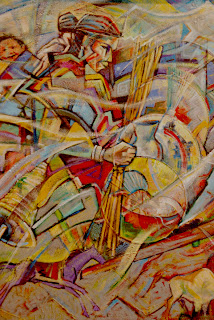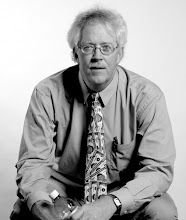It's starting to sound like a broken record:
Another great day on the Navajo Nation for the members of the 2013 Navajo Oral
History project.
Thursday, May 23, saw the class break into two
groups and travelling to two different cities to conduct interviews with Navajo
elders for their documentary journalism projects.
One group headed to Flagstaff, Arizona, for a
second interview with renowned Navajo artist Baje Whitethorne Sr.
Another group went to the western edge of the
Navajo Nation, to Tuba City, Arizona, and interviewed Peter MacDonald, a Navajo
Code Talker during World War II, and current president of the Navajo Code
Talker Association.
(above photo by Darin Strohmenger)
Debb Teller, a Diné College student, skillfully interviewed Peter MacDonald while Tom Hays shot video, Jolene Kuisle took still photographs and Shiloh Gulbranson transcribed the interview. Assisting the interview team were Whitney Harlos, Adam Maciejczak and Darin Strohmenger.
(above photo by Darin Strohmenger)
Peter brought out the Congressional Silver Medal he received in 2001.
These were awarded to all Navajo Code Talkers who served during World War II.
The Original 29 Code Talkers -- the ones who helped create the code, and used
it in battle -- earned Congressional Gold Medals.
(above photo by Darin Strohmenger)
WSU Student Whitney Harlos sketched a drawing of Peter MacDonald while
she listened and observed during the interview.
In an interview that lasted nearly two hours, the
students became bonded with Peter MacDonald and listened intently as he
explained the role of the code talkers during the war, the training code
talkers went through, and the value of a Navajo upbringing to the men who would
be required to memorize more than 600 terms in a double-code. He also talked
about his childhood, his family and traditional Navajo culture and values.
Before they left his home, the team that is assigned to produce a
documentary film about Peter's life had their picture taken with him. Pictured (left to
right) are: Tom Hays, Shiloh Gulbranson, Peter MacDonald, Debb Teller and
Jolene Kuisle.
Other Navajo Oral History project participants present
also had their photo taken with Peter. It's not everyday a person gets to spend
time with-- and have their photo taken with-- a true American hero.
(above Adam Maciejczak poses with Peter MacDonald, photo by Shiloh Gulbranson)
(above Adam Maciejczak poses with Peter MacDonald, photo by Shiloh Gulbranson)
For those that don't know, the Navajo Code Talkers
were young, bi-lingual Navajo men in the 1940s who enlisted in the U.S.
Marines, and used their native language in a code throughout the South Pacific
during World War II. The Navajo Code was the only code in the history of the
United States that was never broken by the enemy. The Code Talkers and their
ability to quickly and accurately transmit and receive information between the
front lines and the command centers surely saved thousands of lives and
shortened the war.
Code Talkers were deployed in each of the six
Marine divisions active throughout the South Pacific and were active in battles
on Iwo Jima, Saipan, Tinian, Kwajalein Atoll, Guam, Roi-Namur, Bougainville,
Guadalcanal, Pelilieu and other sites.
As the visit with Peter MacDonald ended, everyone
shared hugs, and made plans to meet again next week for a second interview.
On the way back to the Diné College campus, the
home base for the Navajo Oral History project, the group stopped at the small
Navajo Code Talker Museum in Kayenta, Arizona.
(above three photos by Whitney Harlos)
(photo by Darin Strohmenger)
(above three photos by Whitney Harlos)
It's important to note that Peter MacDonald, in his
role as president of the Navajo Code Talker Association, is actively promoting
a fundraising project to build the National Navajo Code Talker Museum and
Veteran's Center in Window Rock, Arizona, the capital of the Navajo Nation.
Information about the project (and an opportunity to donate to help make the
project become a reality) is available at the organization's web site: http://www.navajocodetalkers.org.
The Baje Whitethorne group had a bit farther drive, and returned to campus later in the evening. While in Flagstaff with Baje, they interviewed him a second time, and then watched him paint for a bit.

Lionel Harvey listening while Baje Whitethorne Sr. is interviewed.


(above three photos by Elise Nelson)
The photos above and below include Nik Strand doing photography work and having some fun with Baje's grandson, Cash.
(above photo by Nik Strand)
The Baje Whitethorne group had a bit farther drive, and returned to campus later in the evening. While in Flagstaff with Baje, they interviewed him a second time, and then watched him paint for a bit.
(above four photos by Skylar Ogren)

Lionel Harvey listening while Baje Whitethorne Sr. is interviewed.


(above three photos by Elise Nelson)
The photos above and below include Nik Strand doing photography work and having some fun with Baje's grandson, Cash.
(above four photos by Cara Mannino)
(above photo by Nik Strand)
(above photo by Nik Strand)
The group also stopped by the new Twin Arrows Casino, which was having its grand opening the next day, to see large murals painted by Baje Whitethorne Sr. in collaboration with a number of other prominent Navajo artists. As expected, there were severe limitations on what they could photograph.
(above photo by Skylar Ogren)
Here are some samples of the large murals in the Twin Arrows Casino, featuring work by Baje Whitethorne Sr.
Back on the Diné College campus in Tsaile, Arizona, Nik Strand and a few other students experimented with night photography and light writing.
Editor's Note:
Something weird is happening with fonts today. I'm not sure why some text is one font, and some another, and sizes of text varies. After trying to correct it for more than 30 minutes, I gave up, deciding it was close enough, and readable.
The group also stopped by the new Twin Arrows Casino, which was having its grand opening the next day, to see large murals painted by Baje Whitethorne Sr. in collaboration with a number of other prominent Navajo artists. As expected, there were severe limitations on what they could photograph.
(above photo by Skylar Ogren)
Here are some samples of the large murals in the Twin Arrows Casino, featuring work by Baje Whitethorne Sr.
(above four photos by Brett Gustafson)
Back on the Diné College campus in Tsaile, Arizona, Nik Strand and a few other students experimented with night photography and light writing.
Editor's Note:
Something weird is happening with fonts today. I'm not sure why some text is one font, and some another, and sizes of text varies. After trying to correct it for more than 30 minutes, I gave up, deciding it was close enough, and readable.













































Glad you are doing this work! Just curious did you talk to former Navajo Chairman Peter MacDonald about his political career?
ReplyDelete